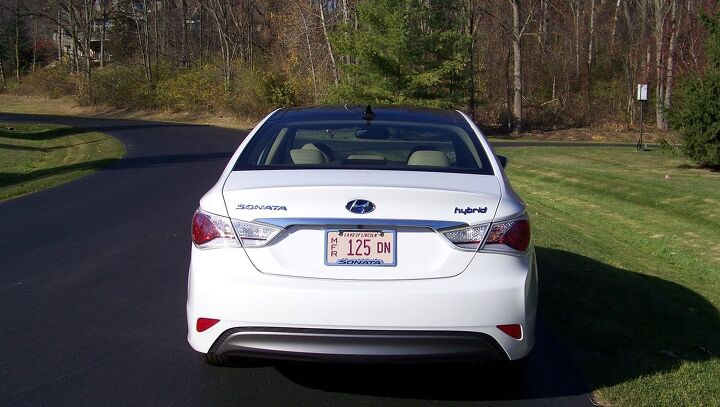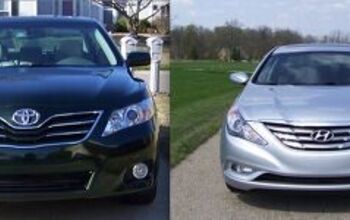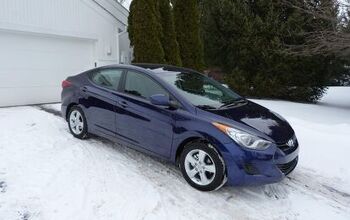Review: 2011 Hyundai Sonata Hybrid
Though an upcoming 429-horsepower 5.0-liter V8 might suggest otherwise, Hyundai intends to lead the industry in fuel economy. As recently as 2005 this would have seemed a pipe dream. That year’s Hyundai Sonata automatic managed fuel economy ratings of only 19/27 MPG from the EPA (2008+ system), well below the 21/31 achieved by the Honda Accord and Toyota Camry. The 2011 Sonata does far better: 22/35. But the glory, of course, goes to hybrids, and so the Sonata will soon be available in hybrid form. The projected EPA numbers: 36/40. Is Toyota’s hybrid leadership in danger?
By arriving late to the hybrid party, Hyundai had ample opportunity to learn from others’ failures. One lesson: car buyers expect a hybrid to look different. Hyundai’s solution: graft an exceedingly ugly nose, complete with an XXL hexagonal lower grille, onto the Sonata. LED tail lamps take the other end of the car up a notch. Exhaust is the opposite of green, so the pipe is concealed. The exterior tweaks aren’t solely for aesthetics: they also reduce the drag coefficient from an already Volt-beating 0.28 to a Prius-tying 0.25.
The interior is standard stylish Sonata, with a few notable exceptions. An “eco guide” replaces the tach. The trip computer receives a mild upgrade. The optional leather upholstery gains perforations. The optional sunroof gains a rear panel—an odd choice since this should reduce efficiency by adding weight and increasing the load on the AC. And a surprise: the HVAC airflow control is properly three pieces rather than one, so it provides the function as well as the form of the Volvo control that clearly inspired it. As in other hybrids, trunk space takes a hit, dropping from 16.4 to 10.7 cubic feet.
For their hybrids, Ford and Nissan followed the Toyota HSD model. Hyundai has taken a different route. Where HSD employs a planetary gearset CVT, Hyundai retains the regular Sonata’s six-speed automatic—but not quite all of it. Unlike in the late, unlamented Honda Accord Hybrid, which similarly sandwiched a (much weaker) electric motor between a conventional gas engine and a conventional automatic transmission, there’s no torque converter. Instead, the electric motor handles transitions to and from a dead stop. The Sonata Hybrid’s engine also receives one substantial modification. As in the HSG, the 2.4-liter four runs through an Atkinson cycle to virtually lengthen the ignition stroke and so squeeze a bit more energy out of each cycle. The cost of closing the intake valves part way through the compression stroke: 29 peak horsepower (now 169).
The innovation that makes this unique powertrain possible: a clutch between the engine and electric motor. The Honda Accord Hybrid’s engine could not be declutched from the rest of the powertrain, so that car could not run on electric power alone and had to retain the inefficiencies of a torque converter. By declutching the engine, the Sonata Hybrid can (allegedly) cruise up to 62 MPH on electric power alone.
Finally, Hyundai opted for a lithium-polymer battery rather than the NiMH batteries employed by the others. The lithium-polymer batter is more compact and lighter. Partly as a result the Sonata Hybrid weighs only 3,457 pounds, over 200 less than the Camry and Fusion. Downsides? Hyundai isn’t suggesting any, but the newer technology is less proven and can’t be cheap.
How does it behave? Total gas-plus-electric power output is a little higher at the peak, and notably higher at low rpm, where the 40-horsepower electric motor contributes 151 pound-feet of twist. So, like its direct competitors, the Sonata Hybrid feels plenty quick. The drivetrain sometimes plays a touch rough at low speeds—perhaps the clutch engaging and disengaging—but otherwise behaves well. The conventional automatic feels so much more normal than a CVT—it can even be manually shifted—that the deleted tach is actually missed.
So what’s not to love? Fuel economy. I barely touched 40 in a largely highway stint. When did 40 become disappointing? When the 274-horsepower Sonata 2.0T achieved the same. In suburban driving, I managed “only” 31.3 despite a very light foot. The 36 promised by the EPA numbers wasn’t happening. And while electric-only operation might be possible up to 62 MPH, it doesn’t actually happen unless you’re extremely light on the gas. A tailwind and/or a downhill slope might also be required. The Toyota-type system seems to have a clear advantage in city and suburban driving. In these conditions the Ford Fusion Hybrid tops the Sonata by about 10 MPG. Drive the Sonata Hybrid aggressively, and suburban fuel economy falls below 20. A Ford Fusion Hybrid still managed 27 when subjected to my lead foot.
Better driving aids might help, or would at least be more entertaining. Toyota, Ford, and others have been providing ever more precise and detailed feedback to help drivers adjust their driving style to maximize efficiency. In contrast, the Sonata Hybrid’s “eco guide” is little better than the MPG gauge BMW has been offering for decades. A vine that grows and loses leaves against a background that changes color, both based on your driving style, can be summoned up, but it’s as useless here as it is elsewhere. Sought but not found: some indication of the limits of the regenerative braking system, beyond which the conventional brake rotors cut in to convert kinetic energy into heat.
With curb weight up just a couple hundred pounds, and with the steering electrically-assisted in both cases, the Sonata Hybrid steers and handles much like the regular Sonata. Meaning better than average, and bordering on fun to drive, but not as taut as the Fusion Hybrid. With the optional 17-inch wheels the ride is more jittery than the Sonata Limited’s. The likely culprit: while the tire size is the same, 215/55VR17, the Limited wore Hankook H431s while the Hybrid is shod with Kumho Solus KH25s. Even so, the ride-handling balance could be the best in the segment, with sharper handling than the Camry and a smoother ride than the Fusion.
Taken by itself, the 2011 Hyundai Sonata Hybrid is a very good, even excellent car. But, even more than most hybrids, it makes little rational sense. Despite the lofty promise made by the EPA city figure, the hybrid system doesn’t seem to improve fuel economy nearly as much as the Toyota-type system in city and suburban driving. It fares better on the highway—40 MPG for a roomy, semi-lux sedan is certainly admirable—but must then contend with the regular Sonata, which does nearly as well, even with the 274-horsepower turbocharged engine. Pricing for the Hybrid hasn’t yet been announced. If Hyundai charges $2,500 or less extra for the hybrid bits, which will be cut in half by a $1,300 tax credit, and the technology turns you on more than the front end turns you off, then by all means go for it. Otherwise, the regular Sonata is a better bet.
Hyundai made this vehicle available for review at a ride-and-drive event.
Michael Karesh owns and operates TrueDelta, an online source of automotive reliability and pricing data.
Michael Karesh lives in West Bloomfield, Michigan, with his wife and three children. In 2003 he received a Ph.D. from the University of Chicago. While in Chicago he worked at the National Opinion Research Center, a leader in the field of survey research. For his doctoral thesis, he spent a year-and-a-half inside an automaker studying how and how well it understood consumers when developing new products. While pursuing the degree he taught consumer behavior and product development at Oakland University. Since 1999, he has contributed auto reviews to Epinions, where he is currently one of two people in charge of the autos section. Since earning the degree he has continued to care for his children (school, gymnastics, tae-kwan-do...) and write reviews for Epinions and, more recently, The Truth About Cars while developing TrueDelta, a vehicle reliability and price comparison site.
More by Michael Karesh
Latest Car Reviews
Read moreLatest Product Reviews
Read moreRecent Comments
- Tassos Jong-iL North Korea is saving pokemon cards and amibos to buy GM in 10 years, we hope.
- Formula m Same as Ford, withholding billions in development because they want to rearrange the furniture.
- EV-Guy I would care more about the Detroit downtown core. Who else would possibly be able to occupy this space? GM bought this complex - correct? If they can't fill it, how do they find tenants that can? Is the plan to just tear it down and sell to developers?
- EBFlex Demand is so high for EVs they are having to lay people off. Layoffs are the ultimate sign of an rapidly expanding market.
- Thomas I thought about buying an EV, but the more I learned about them, the less I wanted one. Maybe I'll reconsider in 5 or 10 years if technology improves. I don't think EVs are good enough yet for my use case. Pricing and infrastructure needs to improve too.










































Comments
Join the conversation
DO NOT BUY THIS CAR!!!!!!!
We purchased ours in May and it has been in the shop 6 times, a total of now 33 days. It constantly shuts itself down, whether you are stopped or driving 45mph. YES shuts it's self down! No breaks, no steering no nothing. They have replaced the wiring, the "hammock" for the hybrid system, the hybrid computer system, did a computer soft wear reboot and now replacing the hybrid connector kit. We have been told by several other owners that they are having the same issues. We have hired a lemon law attorney who has taken the case to get all of our money back.